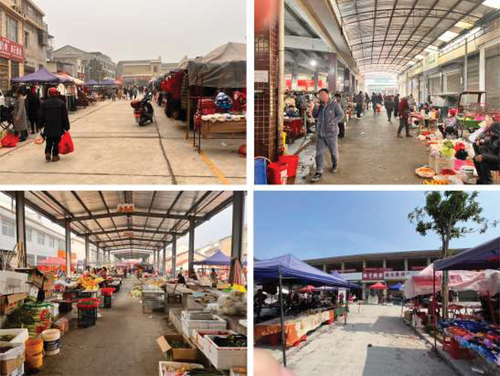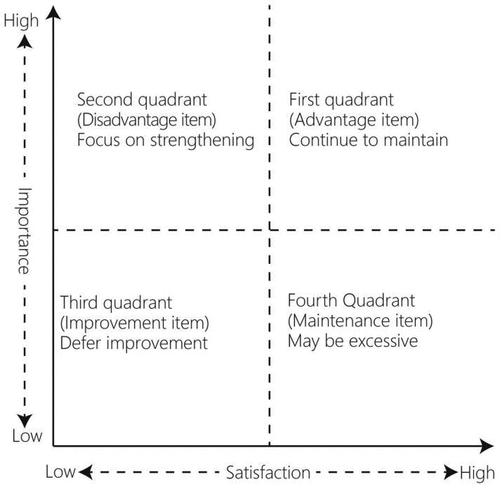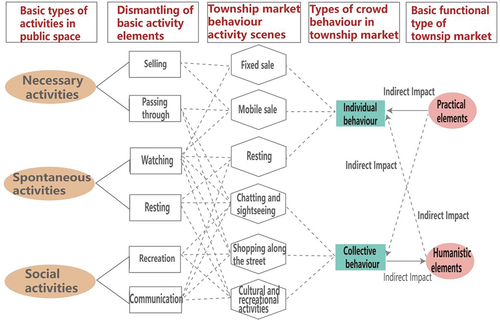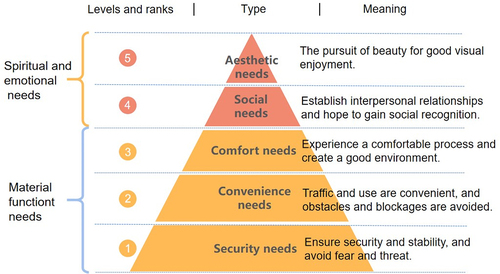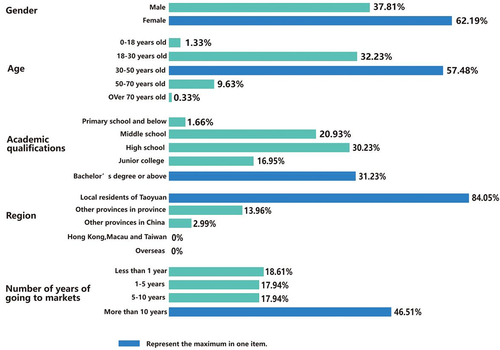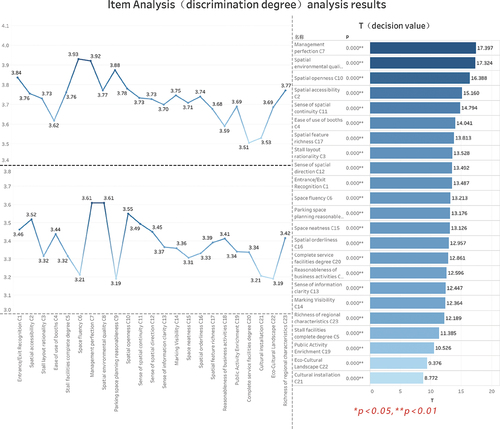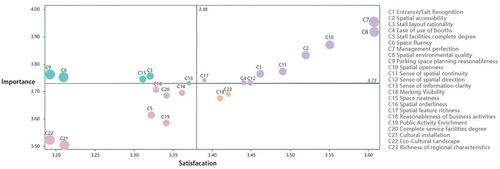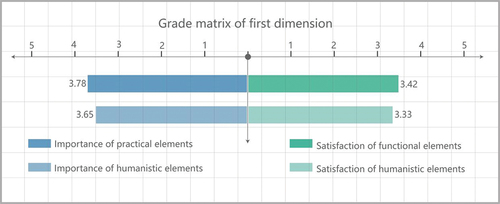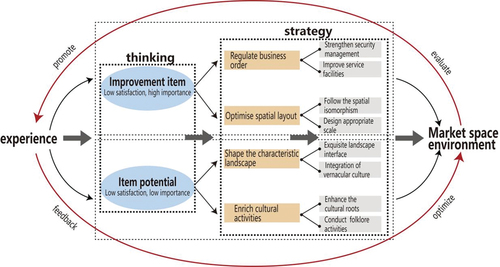 ?Mathematical formulae have been encoded as MathML and are displayed in this HTML version using MathJax in order to improve their display. Uncheck the box to turn MathJax off. This feature requires Javascript. Click on a formula to zoom.
?Mathematical formulae have been encoded as MathML and are displayed in this HTML version using MathJax in order to improve their display. Uncheck the box to turn MathJax off. This feature requires Javascript. Click on a formula to zoom.ABSTRACT
The township traditional market environment is declining due to the lack of perspective and consideration of the behaviour needs of the crowd. In this study, the activity space of four township traditional markets in Taoyuan County, Changde City is taken as the research object, and the evaluation index of spatial environment experience of rural markets is established from the perspective of behaviour demand. Using Importance-Performance Analysis (IPA) to study users’ views on the market environment. The results show that: (1) there are significant differences in users’ views on the importance and satisfaction of market environment elements, among which the gap between supply and demand is relatively large, such as spatial smoothness (C6), rationality of parking space planning (C9), ecological and cultural landscape (C22). (2) The people in township traditional markets pay more attention to the practicality of space and the low-level material needs, while the spiritual needs and humanistic elements are not very concerned. Therefore, in this study, we suggest that in the subsequent renovation, first of all, optimize the market space layout; Secondly, strengthen the safety management of township markets and standardize the market operation order; Thirdly, refine local cultural genes and enrich market cultural activities; Finally, adapt measures to local conditions and create a market landscape with regional characteristics.
1. Introduction
1.1. Research background
President Xi Jinping has stressed that “to promote Chinese-style modernization, we must comprehensively promote rural revitalization and solve the problem of unbalanced development between urban and rural areas and between regions”. To realize the Chinese-style modernization, we must comprehensively promote the rural revitalization (Shen and Liu Citation2023). The township market space is both the entrance and exit of rural economic flow, as well as a product of the natural, social, economic, and historical development of its region, influencing the development of the township economy. The drive towards improving township economies and their attractiveness to surrounding rural residents is strongly related to the characteristics of the township market space. Eighmy (Citation1972) identified three functions of township markets into three categories: function of facilitating local exchange, promoting interregional trade, and providing urban goods and services to a geographically dispersed rural population (referred to as central location functions). Besides, the market is a social facility with many production activities, a place with many functions such as emotional communication, public life and cultural display, and a continuation of people’s daily life (Şahinalp and Günal Citation2012).
With the continuous development of society, township markets are facing great challenges under the impact of the new era. On the one hand, the new transaction forms are constantly eroding the original functions of traditional markets. Rural residents began to imitate the lifestyle of urban residents, regarded shopping in supermarkets and department stores as a part of fashion life, and gradually learned to use shopping in supermarkets instead of going to the markets (Guan Citation2016).
On the other hand, the historical limitations of the township market itself are gradually revealed, such as poor market service facilities, street instead of city, and road instead of collection. There are few fixed vendors, many mobile vendors, and most of them are of low quality, which is inconvenient for supervision and management. Unreasonable location selection reduces the efficiency of market operation (Shi Citation1995). In today’s increasingly diversified consumption patterns, the traditional market is inevitably declining, and the once vibrant township market is gradually declining, facing problems such as functional facilities and existing demand disconnection, single form, cultural loss and insufficient vitality. Therefore, it is urgent to solve the existing problems of the township market.
1.2. Literature review
1.2.1. Township traditional market
In the early days, scholars at home and abroad mostly explored the relationship between market development and economic, historical and social development from the fields of economics, history and sociology (Ehinmowo and Ibitoye Citation2010; Kio-Lawson, John, and Chikagbum Citation2015; Myers Citation1989; Smith Citation1979; Wu Citation2008; Zhang and Wu Citation2010). In addition, social sector research pointed out the cultural and social status of these markets (Masaru and Badenoch Citation2013). And Altaş (Citation2016) regarded the market as a cultural commercial space, and analysed the nature, economic influence scope and basic problems of the market. The author believed that the market had a historical nature with traces of traditional and cultural values, so we should focus on protecting cultural characteristics in the protection and inheritance. So far, some scholars have begun to study the township traditional market from the perspective of space environment and behaviour activities. For example, Zheng et al (Citation2013) analysed the spatial structure of the market and found that the overall spatial structure of the market has a high degree of integration and clarity through spatial syntax, so the spatial structure is relatively simple. In order to activate the declining regular market, it is necessary to strengthen the strategy of locality and promote tourists’ consumption. Na (Citation2018) explored the market space form, stalls, traffic system, space nodes, service facilities and the living habits of market participants. Lee (Citation2017) analysed the present situation of the basic elements such as architecture, use and spatial characteristics through the cases of traditional markets successfully revived by various methods, and put forward the revitalization methods from four aspects: place, process, promotion and people. Aram et al(Citation2019) proved that the market with green space can enhance the degree of visiting the market and social behaviour, especially the degree of acquaintance, belonging and cooperation between neighbours. Choi (Citation2020) proved that improving various spaces and facilities in the traditional market has an upward effect on restoring market vitality. These studies mainly focus on qualitative research, while ignoring the dominant position of people in space, and do not consider the needs of the activities and the satisfaction and spatial preference of the spatial environment of the market, which is not conducive to improving the vitality and further development of the township market. Studies have shown that users’ opinions are more important than experts’ opinions in understanding the interaction between human beings and the environment (Kuller Citation1991). Therefore, it is necessary to consider the relationship between human behaviour demand and space, as well as the priority of transformation, in order to put forward targeted planning and design strategies to better meet users’ cognition and demand preferences for the township market environment.
1.2.2. Behavioural demand theory
The related theories of behavioural needs include environmental psychology, environmental behaviour and demand theory. Environmental psychology emphasizes the interaction among objective physical environment, human behaviour and subjective psychological experience (Moore, Citation1989). Environmental ethology holds that behaviour is the result of the interaction of environment and human needs (Li Citation2008). The main research basis of demand theory is the hierarchy of needs theory put forward by Abraham Maslow in the book “Theory of Human Motivation” in 1943 (Bridwell Citation1976). He systematically summarized human needs and divided them into five levels from low to high (Hale et al. Citation2019). In recent years, many scholars have studied public space from the perspective of behavioral needs. For example, Wang (Citation2009) research on the design mode of two-way circular architecture based on users’ behaviour needs provides reference for design by increasing the feedback of designers and users through the theory and method of post-use evaluation.Based on the users’ behaviour demand, Wang (Citation2014) studied the design of the public space of urban commercial street, and put forward the optimization strategy for the space. Yang (Citation2016) introduced the research method from the perspective of behavioural needs into the research of public space in subway stations, and put forward universal design strategies for a wide range of station spaces, including passages, entrances, stations and platforms. Based on Maslow’s demand theory, Linwei et al. (Citation2021) evaluated the residents’ perception of five typical communities in Xiamen, and found that the residents’ cultural perception was significantly lower than their physical and psychological perception, that is, the higher their perception level, the more difficult it was to realize the residents’ needs. The above research provides some ideas for this study. There are some similarities between the township market and the former, but there are also some differences, which have certain research value (Oliver Citation2010).
1.2.3. IPA analysis method
IPA was first proposed by Martilla and James (Lai and Hitchcock Citation2015), and was widely used in tourism, management, geography and other fields in the early days. It is a measurement method gradually introduced into the management of natural and artificial environment in recent years (Ivan Citation2015). Its basic principle is to compare the differences between users’ expectations of products and actual experience, so as to understand consumers’ satisfaction. IPA method relies on the collected survey data and the calculation and comparison of performance and importance scores of different variables to reveal the advantages and disadvantages of products or services and help decision makers find areas that need further attention and improvement (Martilla and James Citation1977). In the study of public space, IPA is used to evaluate users’ intuitive experience of urban park service system and the relationship between supply and demand of service facilities (Gai et al. Citation2023). Research from the perspective of crowd experience helps decision makers and planners to better understand the relationship between people and the environment instead of studying human activities or environmental factors. Conversely, people can be encouraged to support and participate in various public affairs and market construction.
1.3. Purpose of the study
In this study, four representative township markets in Taoyuan County, Changde City are selected as examples, and the relationship between user demand and the supply of township market environment is discussed by combining environmental behaviour and Maslow’s hierarchy of needs theory. In addition, we will also understand the current user’s demand level and determine the transformation priority of the market environment elements. The research results show that the construction of practical elements of market environment can effectively enhance people’s sense of experience. At the same time, the government and planners should pay attention to the construction of humanistic elements in the environment of township markets and adopt targeted transformation strategies. In addition, in the process of policy formulation and planning, we should communicate with the public more to effectively improve user satisfaction and achieve a balance between supply and demand. This study will not only reveal the relationship between user behaviour needs and market environment elements, provide targeted suggestions for the optimization of township market environment, but also bring inspiration for the government and planners to the construction of towns.
2. Methods
2.1. Research ideas
The process of this research process is divided into four steps. First, through field research, interviews, behaviour notes, and other research methods, the basic behaviour patterns and behaviour needs of township market people are analysed, so as to divide their needs into levels. Secondly, according to the characteristics of township market space, we record the space of four township markets through field visits, photographs and photography, and get the overall understanding of the market space layout, space types and scales, and then refine the current situation of the space environment of township markets on the basis of existing research to obtain evaluation indicators. Thirdly, through the questionnaire, people’s evaluation of the township market environment is obtained, and the data are statistically analysed, combined with IPA quantitative data, so that the research results are intuitive. Finally, through the analysis and discussion of the results, the optimization strategy of spatial environment experience of township markets based on behavioural needs is refined.
2.2. Object of the study
Taoyuan County is located in the northwest of Hunan Province. Taoyuan County has existed for more than 1,000 years. The division of the county’s internal affairs has undergone many major changes. By 2019, Taoyuan County has jurisdiction over 2 streets, 24 towns and 3 townships, most of which still retain the traditional trade activities of the market. In this study, we selected representative township markets in Taoyuan County, which include Jiaqiao Township, Pantang Township, Mazongling Township, Ligong Port () as case studies. These townships have existed for a long time, and most of the markets are located along the street. The markets are located in the streets on the main axis inside the townships, including some branches connected with the main axis (). The overall spatial layout is scattered, the living environment is poor, and there is a lack of experience, which needs to be improved urgently.
2.3. Research method
This study used IPA analysis. Hierarchical analysis method is to score the elements of each level, judge its relative importance, form a judgment matrix, and calculate the importance score of each index (Saaty Citation1980). IPA mainly uses the matrix correlation method to construct a two-dimensional and four-quadrant grid coordinate diagram, which is defined as the first quadrant with high importance and high satisfaction, the second quadrant with high importance and low satisfaction, the third quadrant with low importance and low satisfaction, and the fourth quadrant with low importance and high satisfaction in order to determine the priority of improvement ().
2.4. Construction of evaluation indicators combined with IPA
2.4.1. Hierarchical division of behaviour needs of people in township markets
In his 2002 work, Life Between Buildings, Gehl (Citation2002) classified human activities in outdoor public space into three types: necessary activities, spontaneous activities, and social activities. The author also proposed that the types of activities in the township market are also closely related to the shaping of spatial environment. After the field research, we followed Gehl’s suggestion and summarized the basic elements of behavioural activities of people in the market according to his three types ().
Table 1. Elements of behavioural activities in the space of the township marketplace.
In order to distinguish the frequency of the three types of activities and the types of pedestrians in the township market space, three groups of 10 people were interviewed. The authors also organized the three types of activity into more specific subtypes. The necessary activities were divided into the specific behavioural scenarios of “fixed sales” and “mobile sales”. The spontaneous activities were divided into two specific behavioural scenarios, “resting” and “chatting and sightseeing”. By organizing the social activities into the two specific behavioural scenarios of “shopping along the street”, and “cultural and recreational activities”, and by understanding the behavioural expressions of the observed people up close in the real-life environment of the research area (Cai, Yu, and Zhang Citation2015), the main types of behaviour in the township market were ultimately divided into two categories, namely, individual and collective behaviour ().
Individual behaviour refers to the type of behaviour in which the crowd has a clear behavioural purpose in the township market and relies on each individual’s ability and information to complete their travel task. This category mainly involves three types of behavioural activity: fixed sales, mobile sales, and resting. Collective behaviour refers to the leisure and recreational activities of the crowd in the township market; this is a more relaxed state, in which people are happy to receive and respond to information stimulation from other individuals or phenomena. This category mainly involves elements of behavioural activities such as watching, communication, and recreation; several behavioural demands are thus derived through these three types of activity ().
Table 2. Correspondence of behavioural demand types in township markets.
Based on Maslow’s hierarchy of needs, combined with field investigation, behaviour notes, expert interviews, etc., the above summarized needs are classified. The material needs include convenience needs, safety needs and comfort needs, and the spiritual needs include social needs and aesthetic needs ().
2.4.2. Construction of environmental factor evaluation indicators
Many scholars have given different definitions of the constituent elements of space. Ashihara, Yoshinobu (Citation1970) divided the constituent elements of space into two parts: scale and texture. Peng (Citation1998) produced a typological comparison and division of the internal space of a building into six aspects – spatial volume, enclosure, planar separation, spatial proportion, interface treatment, and colour texture – forming a common architectural vocabulary. Lynch (Citation2001) categorized the constituents of the physical form of urban imagery into five elements: roads, boundaries, areas, nodes, and signifiers. Each element reflects a portion of the masses’ perception of the city, and together they constitute the overall public imagery of the city. According to Xin (Citation1992), the creation of space can be divided into “spiritual space” focusing on consciousness, “practical space” focusing on material conditions, and “structural space” focusing on durable use, according to two basic elements of space design: practicality and humanism. In our analysis of the spatial elements of the township market, its composition is similarly divided into two element types, namely, practicality and the humanistic. According to the past research on public space, the research on space practicability is mostly reflected in accessibility, transportation system, security measures and guiding signs (Lee Citation2017; Moeini Citation2012; Prajawisastra, Aryanti, and Minggra Citation2018). On this basis, according to the characteristics of township market, booth facilities have been added. The study of space humanity is embodied in space display, activity content and art display (Yang Citation2016). Based on the above research, this study has established an index system for evaluating the market environment. The practical elements are divided into five categories: “entrances and exits, booth facilities, security measures, transportation facilities and guiding signs”, while the humanistic elements are divided into three categories: “space display, activity content and art display” (), and the evaluation index of each dimension is determined according to the characteristics of the market elements.
Table 3. Organization of spatial elements of township markets.
There is a certain correspondence between the spatial environment of township markets and people’s behavioural needs. Practical elements refer to the part that carries the basic functions of the market, corresponding to the physiological needs in Maslow’s hierarchy theory. Humanistic elements refer to the part of improving the environmental quality of township markets, which corresponds to Maslow’s psychological needs. Then, through further research on the field samples, the internal correlation degree is explored, and the hierarchical model of crowd behaviour demand is constructed by combining the above-mentioned components of township markets, and finally the spatial environment evaluation framework of township markets based on demand hierarchy is generated ().
Table 4. Environmental evaluation framework of township markets combined with demand hierarchy.
2.5. Questionnaire distribution and retrieval
The questionnaires were distributed to people going to market during market days in the townships of Ligong Port, Jiaqiao Township, Pantang Township, and Mazongling Township. The questionnaire was divided into basic information and demand scales, importance scales, and satisfaction scales, using 5-point Likert scale ranging from 1 (very unimportant/very dissatisfied) to 5 (very important/very satisfied)in light of similar studies (Hu et al. Citation2022; Bernard Citation2017). The questionnaires were distributed from April to June in 2022. Participants were selected by stratified random sampling at multiple locations in the market. A total of 320 questionnaires were handed out at each market, and 304 valid questionnaires were collected, with a return rate of 95% that was deemed high and adequate for this study. The authors promised that the questionnaire data was obtained after explaining the purpose of the questionnaire and communicating with the interviewees, and promised that it would not involve privacy issues. The interviewees understood the situation and agreed to accept the interview, so there was no conflict of interest.
3. Results
3.1. Participants’ characteristics
The sample data were combined, totaling 304 copies. shows the socio-demographic characteristics of the participants. Men account for 37.81% and women account for 62.19%, and the male population is much lower than the female population. Among them, people aged 30–50 account for 55.63%, and more than 80% are local residents with low education level. Most users have been to the market for a long time, and nearly half of them have been to the market for more than 10 years. Through on-the-spot investigation, we know that there are few employment resources and educational resources in towns and villages. Most adult men go to work in big cities, and students go to school all the year round, which leads to the shortage of new forces in the market. Therefore, the data also reflects the demographic characteristics of the region participating in market activities.
3.2. Analysis of spatial perception factors of township markets under behavioural demand
Before analysing the variables of each factor, in order to ensure the validity of the received questionnaire, the reliability and validity of the questionnaire should be tested by SPSS 26 software. Cronbach’s α coefficient is used to measure the reliability of Likert scale, and Cronbach’s α is calculated as follows:
In the formula, is the number of samples;
indicates the score variation of all subjects on the questions;
is the variance of the total score of all subjects.
The test results show that the α coefficient of the importance scale is 0.983 (>0.8), and the α coefficient of the satisfaction scale is 0.983 (>0.8). The reliability is very good, which indicates that the questionnaire has a high internal reliability in reflecting the importance and satisfaction of people’s needs for the space environment of township market.
Through the data analysis of 23 indicators, the average data of 23 indicators is calculated, and the evaluation model is established. The formula used was as follows:
where is the population’s evaluation of factor importance and satisfaction,
is the evaluation score of each person on the
factor index,
is the sample size of each rating score of the
factor, and N is the total number of samples to establish the needs importance-satisfaction evaluation. Statistics were calculated to show the distribution of the elements of the spatial environment of the township markets in terms of satisfaction and importance. And difference contrasts using the one-way variance test. The high and low groups were significant for all 23 indicators (p < 0.05), meaning that 23 indicators were well differentiated and should be retained ().
As can be seen from , users’ satisfaction with the environmental experience of township markets is generally not high. The average score of each experience element of the market is between 3 and 4, and the highest score is only 3.61, which means that the overall satisfaction of users with each experience element of the township market is between “average” and “relatively satisfied”, which shows that the evaluation results of users’ environmental experience of the township market are not ideal. Secondly, the importance score is higher than the satisfaction score. This shows that users attach great importance to the market environment, but are not satisfied with its performance. All 23 indicators show similar results. It is worth noting that “the completeness of service facilities (C20)” has the lowest importance score, which indicates that people’s demand for the completeness of service facilities in the market is relatively low. The importance score of “spatial patency (C6)” is the highest, which shows that people have the highest demand for the spatial patency of the market. The satisfaction score of “management perfection (C7) and space environmental quality (C8)” is the highest, indicating that the market management perfection and space environmental quality are relatively good. The performance score of “parking space planning rationality (C9) and ecological cultural landscape (C22)” is the lowest, which shows that the market has a great lack of spatial planning and cultural display. Interestingly, the biggest difference between importance and satisfaction was also observed in spatial smoothness (C6), parking space planning rationality (C9) and ecological and cultural landscape (C22), which indicated that the crowd thought these indexes of the market were very important, but they were not satisfied with their performance.
The importance and satisfaction evaluation (IPA analysis) of environmental factors in rural markets is constructed. By using the matrix correlation method, the importance and satisfaction of environmental factors affecting markets are corresponding, and the importance boundary value is 3.71, and the satisfaction boundary value is 3.40, which are respectively included in the corresponding analysis diagram containing four quadrants, and the IPA evaluation matrix diagram is obtained. According to the above four-quadrant diagram, combined with the field investigation, the environmental elements are prioritized and divided into four regions to obtain the IPA evaluation matrix diagram ().
The first quadrant is the area of high importance and high satisfaction. This indicates a very important influence on the behavioural activities of crowds at markets, and that the crowd’s satisfaction with the current situation is rated high and needs to be maintained. Spatial accessibility is reflected in traffic convenience and identification of entrances and exits; security facilities are reflected in the efficient management and the quality of spatial environment; the traffic system is reflected in the spatial openness and the sense of spatial continuity; and the guidance signs are reflected in the sense of spatial direction.
The second quadrant is the area with high importance but low satisfaction. These factors play a key role in crowd activity in the market, but user satisfaction is low, so there is an urgent need for improvement and optimization to enhance these features. The results show that the reasonableness of the stall layout of the stall facilities, the smoothness of the space in the security facilities, the reasonableness of the parking space planning in the traffic system, and the sense of information clarity of the guidance signs need to be optimized and improved.
The third quadrant is the area with low importance but high satisfaction, meaning that the factors have a relatively unimportant impact on crowd activity in the town markets but that crowd satisfaction with them is high. The result shows a relative satisfaction with the rationality of business activities and geographical characteristics, so no major changes are needed, only the maintenance of the original arrangement.
The fourth quadrant is the area of low importance and low satisfaction. This quadrant represents items that do not have a strong impact on crowd activity at township markets but also which have a low satisfaction rating from the crowd and as such need a follow-up enhancement. The factors in this zone mainly focus on humanistic elements, including neatness in space display and orderliness, richness of spatial characteristics and public activities in event facilities, cultural installations in services and art displays in the market, and ecological and cultural landscapes. This area is an important for enhancing crowd perception satisfaction. With the improvement of living standards in towns and villages, this regional factor is likely to become an important factor.
3.3. Analysis on the importance of the behaviour needs and space environment of market crowds
First of all, the analysis of variance of repeated measurement was used to analyze five demand levels and eight spatial elements of the population, and it was found that there were significant differences among all demand levels and spatial elements (P < 0.05) (see ). Then, compare the average satisfaction between the secondary dimension of environment and the demand level (), the order of demand level importance is security > convenience > comfort > aesthetics > sociality (3.87 > 3.76 > 3.74 > 3.64 > 3.58), and the order of spatial elements importance is security measures > transportation system > accessibility > guiding signs > booth facilities > space display > activity content > art exhibition. It can be seen that the practicality of market space will be more important in the hearts of the crowd, while the humanistic elements are not very concerned. The demand level of the market crowd also stays at the low-level material demand, and the perception of the high-level spiritual demand is low. Finally, by comparing the importance of the first-level dimensions of market environment elements (), it is found that the practical elements are obviously greater than the humanistic elements (3.78 > 3.65), which further proves the previous viewpoint.
Figure 9. Histogram of satisfaction and importance of the market environment elements and needs dimensions.
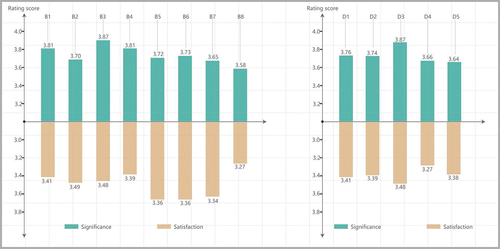
Table 5. Environmental dimension comparison results.
Table 6. Behavioural comparison results.
4. Discussion
4.1. Mismatch between supply and demand of environmental factors in township markets
IPA results show that users have different views on the importance and satisfaction of environmental elements in township markets, which also reflects the relationship between supply and demand of environmental elements in township markets. Compared with humanistic factors, the overall importance of practical factors is more important, but some of them are far below the average level in satisfaction, which also shows the deviation between the high demand of market environment and the actual supply, which may be due to the imperfect infrastructure of township markets and the failure of government planning to take into account the needs of the crowd. Therefore, it needs to be further strengthened, especially the booth layout, spatial smoothness, parking space planning and the clear sense of information of guiding signs in the second quadrant, which are of high importance and low satisfaction, and affect the fluency of the market. Studies have shown that pedestrians will feel pressure and anxiety about places that fail to find their way, which will develop into an attitude of avoiding places and reduce their desire to buy (Pollet and Haskell Citation1979) Therefore, the layout of tour guide facilities in the traditional market is considered to be an important thing. The identification of entrances and exits, spatial accessibility and security measures of the market have greatly affected the smoothness, continuity and adsorption of the market space.
The importance and satisfaction of humanistic elements are relatively lower than those of practical elements, but some of them show great differences in supply relations, mainly in landscape and culture. Landscape greening and the visual aesthetic feeling and cultural implication of cultural activities can increase the attraction of township markets and people’s sense of identity. In the study of public space, social interaction and welfare in East London (Dines et al. Citation2006), it is found that green space can add some special and attractive applications to streets or markets and improve the environmental quality used by people. In the field investigation, we found that the landscape greening area of the township market is very small, which will also reduce the experience quality of the market space. Furthermore, in terms of cultural activities, the traditional market service activities disappeared, such as tool grinders, castrators, dentists, fortune tellers, hairdressers, book writers, tailors and so on (Wei, Citation2018). In addition, in the past, there were many market participants who provided people with entertainment and leisure consumption, such as professional storytellers, theatrical troupes, blind singers, gamblers, entertainers, acrobats, plasterers and pills sellers, and magicians (Xiong Citation2016). These colourful market activities break the boundaries of communication between buyers and sellers, can stimulate more people to gather, and are an important source of market vitality and attraction. At present, such stalls have basically disappeared in various markets, which leads to the lack of diversity and cohesion in the market as a whole, and reduces the original attraction and popularity of the market to a great extent, which cannot be differentiated from the trading space of supermarkets, shopping malls and convenience stores in the city. Therefore, it is necessary to accommodate more diversified activities in the market. Of course, the development of the market needs to keep pace with the times, not to reproduce the past market state, but to update the stall activities. On the one hand, it is necessary to activate the stalls of entertainment consumption activities that still have vitality and attraction in traditional markets, which is also the activation of traditional folk customs. On the other hand, we should explore new entertainment consumption activities that can attract people and increase the market audience. On this basis, it is more meaningful to build more places to encourage social interaction in the market.
4.2. The influence of demand hierarchy on the experience perception of township markets
The ranking results of demand hierarchy obtained by evaluating the environment of township markets are security > convenience > comfort > aesthetics > sociality, which are consistent with Maslow’s demand hierarchy theory and the demand hierarchy established in this paper. That is, the higher the demand level, the more difficult it is for users to realize their needs. However, it also reflects that rural residents are still in a state of low-level demand, township residents have a weak perception of high-level cultural and emotional needs, and the proportion of humanistic elements and practical elements in township markets is out of balance. The results of this study also verify the rationality of the proposed environmental evaluation system of township markets based on behavioural needs.
High-level spiritual needs are formed under the social background with China characteristics, which is the expression of social progress and development and the improvement of people’s living standards. Through the research of Wang et al. (Citation2017), it is found that people pay more attention to basic material needs than mental health in places with relatively backward economy. The public resources of township markets are relatively scarce, and the existing environmental facilities do not consider the high-level needs of township residents. For many township residents who have just passed the subsistence line, their material needs have just been solved, and it is difficult to consider the high-level spiritual needs, which is also reflected in the low perception of the needs of humanistic elements by township residents, and our results also verify this point. With the increasing education level of young people in rural areas, especially since the implementation of the overall rural revitalization strategy in China, many young people with education and urban life background have gradually returned, and they have some knowledge. This puts forward higher requirements for the environmental transformation of villages and towns.
4.3. Influence on township policies and planning
Under the background of increasing inequality of social and economic development in China, the decline of rural areas, the large number of young labourers going out, and the lack of demand and purchasing power of villages for markets all show great challenges. Many studies show that the humanity and diversity of public space help to strengthen social ties and local sense of belonging, and at the same time attract tourists (Pan Citation2015). However, the existing policies rarely consider the humanity of the traditional market in villages and towns. Our research shows that the transformation of the market environment in villages and towns should not be limited to a single economic and trade function, but should be extended to functions conducive to people’s entertainment, leisure and social interaction. The development of township markets needs the strategy of attracting tourists by using humanism.
To some extent, the township market has always assumed the function of a functional complex, but at present, only relying on the spontaneous strength of villagers to maintain this function will obviously lack stamina. Further, the lack of rural young groups in market activities and the low acceptance of new things by the elderly groups have also made the transformation of the market more difficult. Therefore, the market should change from the traditional bottom-up development mode to the bottom-up and top-down development mechanism, from the spontaneous organization of market participants to the joint action of market participants, government managers and market researchers, and develop into a space for accommodating diversified functions, thus promoting the contemporary transformation of the market.
4.4. Environmental optimization strategies to guide the healthy development of town markets
According to the user’s evaluation of the relationship between supply and demand of the market environment, the market can be optimized from four aspects: determining the spatial layout of the township market, standardizing the business order, enriching cultural activities and shaping the characteristic landscape, then construct an optimization framework for the spatial environment renewal of the market () in order to provide reference for improving the spatial environment experience of the market.
4.4.1. Optimizing the spatial layout of the market
In the renewal of township markets, it is necessary to understand the old spatial sequence of township markets and use an appropriate planning layout so that the spatial form flows well. Since the length of time users stay in the space and the speed of their movement through it are influenced by the scale of the street space, it is necessary to create a rich viewing experience for the users of the space by using an appropriate scale. At the same time, the street space of township markets should be designed without changing the main street pattern, and with similar materials and unity of construction methods. In addition, the positions that affect the continuity of the interface should be designed in a complementary way to maintain the continuity of both horizontal and vertical interfaces.
4.4.2. Strengthening the safety management of township markets and regulating the business order of markets
According to the importance of satisfaction evaluation, supporting service facilities must also be improved. These comprise rectification of the township market safety hazards; strengthening of the township market street management; provision of appropriate lanes and parking areas, with parking at both ends of the street (as much as possible); use of the necessary diversions to fundamentally solve traffic chaos and safety problems; and the presentation of an orderly appearance. In the area of vendors’ stalls, it is necessary to further delimit the scope according to the number of various goods stalls. Among them, vegetables, fruits, dried ingredients, meat, general merchandises, clothing and other goods often account for the largest proportion in various markets, and the unit area of vegetable, fruit, department stores and clothing stalls is larger, which should be given more space. The scope of each goods stall shall be defined according to the market conditions, and the boundary shall be negotiable to some extent, which can be flexible according to the actual situation of the market scale. The installation of infrastructure, such as garbage cans, public signs, public toilets, and leisure seats at important nodes and along the streets as much as possible to facilitate consumers’ use of the market features. In addition, there must be an increase in the number of guide signs, improvements to the guide system, enhancement of identification of market entrances and exits, and an increase in ease for consumers to shop and orient themselves in the market. Organizers should provide cultural facilities, such as venues for exhibitions of folk art and youth activity venues set up as close to the central nodes of the market as possible, taking into account the use of such facilities by township residents and consumers. Township markets should be combined with the setting of government administrative functions to improve market management, consultation, fire protection, security, rescue, and other market management facilities in order to regulate the order of market operations.
4.4.3. Enhancing the cultural roots and enriching cultural activities at markets
The township market space can function as a site for assemblies, entertainment, and traffic, and is closely connected to the lives of residents and the activities of consumers. It is a source of a township’s material cultural heritage as well as a carrier of immaterial culture (Gao and Li Citation2019). Therefore, in the process of conservation and renewal, in addition to adhering to the tenets of authenticity and the orientation of cultural living preservation, we should also fully understand the spatial and temporal characteristics of heritage resources in townships, enhance townships’ cultural roots, explore their cultural structure, actively carry out folk culture – related events, and increase their publicity. This can be used to attract social and economic investment and to promote the economic development of the township through cultural heritage and innovation.
4.4.4. Shaping the market landscape with regional characteristics according to local conditions
The main axis street is used as the spine of the spatial skeleton to extend the spatial structure along it on both sides, and a relatively open surface space can be formed as the core node or square to create a combination of “node”, “linear”, and “surface” market spatial forms to enrich the market street landscape interface. The presence of diversified nodes makes the street space more dynamic. In addition to enriching the spatial structure of the planes, the vertical space of the stores, households, and other buildings along the street should maintain their integrity and continuity while undergoing moderate-level changes, alongside elaborate and delicate facade treatment, in order to produce an exquisite street facade landscape.
The construction of marketplaces should be adapted to local conditions, and the unique local cultural connotations should be applied to the construction of each market. In line with the characteristics of local culture and the corresponding needs, the regional characteristics of commercial buildings on both sides should also be highlighted, with their architectural style, materials, and colours reflecting local characteristics.
5. Conclusion
In order to comprehensively and accurately evaluate people’s perception experience of the market environment, based on environmental behaviour and Maslow’s demand theory, this paper divides the behaviour needs of the people in the township market into two levels: material needs and spiritual needs, and the market environment is divided into two levels: practical elements and humanistic elements, and constructs the post-use scoring index of the township market space environment in a two-way way way. Combined with Importance-Performance Analysis(IPA), the satisfaction-importance score of people’s experience in the rural market space environment is analyzed. Through the evaluation of the perceived experience of four township markets in Taoyuan County, the research results show that there is a mismatch between supply and demand in the elements of market environment experience. There is a big gap in space smoothness, parking space planning rationality, ecological and cultural landscape, supply and demand. It is necessary for the government to focus on these elements in market planning. Secondly, the practical factor is an important factor that affects people’s satisfaction with the market experience. The high-level needs of spiritual needs and humanistic elements are not very concerned. This discovery shows that with the continuous improvement of living standards today, the demand level of townships has not kept up because of the unbalanced development. In the future renovation of township markets, attention should be paid to the enrichment of humanistic elements and improve the people’s perception of humanistic elements, which will certainly play an important role in the future of rich life. Applying the analysis results to the improvement priority of market space can enhance the rationality of the old reform priority, rapidly enhance the experience of the market under the condition of limited reconstruction resources, and provide new perspectives and ideas for the renewal, protection and development of township markets. The results of the case study are helpful to promote the market reconstruction in other parts of China.
Although this study provides some opinions on the evaluation of experience satisfaction and importance of township markets, there is still room for improvement. The location of this survey is Taoyuan County, Changde City, and the geographical location is special. There are still some limitations in putting forward 23 demand indicators and demand evaluation. Some researchers believe that the demographic characteristics or socio-economic background of residents have a considerable impact on people’s needs and subjective feelings (Hegetschweilera et al. Citation2017; Suppakittpaisarn et al. Citation2019; Wang et al. Citation2019). However, this paper does not take into account the demand differences among different subjects such as residents, vendors and market participants. Future research should divide the needs of different subjects in the market, so as to meet the behavioural needs of all different subjects in the market. In the future, it is suggested to expand the research samples to strengthen quantitative analysis, obtain the temporal and spatial characteristics of collective activities with the help of modern digital technology, and explore the differences of behaviour needs of township markets in different regions and different attributes, so as to provide refined updates for township markets.
Author contribution
Linhui Hu: Methodology, Formal analysis, Writing – original draft,Writing – review & editing, Conceptualization, Funding acquisition. Tao Liu: Writing – original draft, Methodology, Resources, Formal analysis. Junsen Deng: Visualization, Writing – review & editing, Formal analysis. Xinlan Yu: Conceptualization, Resources, Formal analysis. Siyin Liao: Conceptualization, Visualization. Kang Shen: Project administration, Supervision, Funding acquisition, Validation.
Disclosure statement
No potential conflict of interest was reported by the author(s).
Data availability statement
The data that support the findings of this study are available upon reasonable request from the author.
Additional information
Funding
Notes on contributors
Linhui Hu
Linhui Hu is an associate professor at Guangdong University of Technology. His research interests are environmental behaviour and sustainable design.
Tao Liu
Tao Liu is a graduate student of Guangdong University of Technology. His research interests are urban and rural planning and cultural exhibition design.
Junsen Deng
Junsen Deng is a graduate student of Guangdong University of Technology. His research interests are sustainable design and cultural display design.
Xinlan Yu
Xinlan Yu is a graduate student of Guangdong University of Technology. His research interests are sustainable design and urban landscape design.
Siyin Liao is a graduate student of Guangdong University of Technology. His research interests are sustainable design and cultural exhibition space design.
Kang Shen
Kang Shen is a professor at Guangzhou Academy of Fine Arts. His research interest is architectural cultural heritage.
References
- Altaş, N. T. 2016. Importance of Bazaars as Cultural Commercial Spaces: Erzurum Example. In Bildiri. 2nd International Scientific Conference GEOBALCANICA (pp. 10–12). https://doi.org/10.18509/GBP.2016.30
- Aram, F., E. Solgi, and G. Holden. 2019. “The Role of Green Spaces in Increasing Social Interactions in Neighborhoods with Periodic Markets.” Habitat International 84:24–32. https://doi.org/10.1016/J.HABITATINT.2018.12.004.
- Ashihara, Y. (1970). Exterior Design in Architecture. https://lib.ugent.be/en/catalog/rug01:001291216
- Bernard, H. R. 2017. Research Methods in Anthropology: Qualitative and Quantitative Approaches. Rowman & Littlefield. https://doi.org/10.5860/choice.39-4047.
- Bridwell, W. 1976. “Maslow Reconsidered: A Review of Research on the Need Hierarchy Theory.” Organizational Behavior & Human Performance 15 (2): 212–240. https://doi.org/10.1016/0030-5073(76)90038-6.
- Cai, N., H. Yu, and L. Zhang. 2015. “Application of Participatory Observation and Non-Participatory Observation in Case Studies.” Manage 28 (4): 66–69. https://doi.org/10.5565/REV/PERIFERIA.479.
- Choi, K. 2020. “A Case Study on the Public Space for Traditional Market Revitalization.” Journal of the Korean Chemical Society 11:219–232. https://doi.org/10.15207/JKCS.2020.11.11.219.
- Dines, N., V. Cattell, W. Gesler, and S. Curtis. 2006. Public Spaces, Social Relations and Wellbeing in East London, Queen Mary. University of London. https://www.researchgate.net/publication/236574391_Public_spaces_social_relations_and_well_being_in_East_London.
- Ehinmowo, A. A., and A. O. Ibitoye. 2010. “Periodic Market, a Common Marketing Feature in Akoko Southwest.” Journal of Geography and Regional Planning 3 (12): 361–364. https://academicjournals.org/journal/JGRP/article-full-text-pdf/B1DF95640731.
- Eighmy, T. H. 1972. “Rural Periodic Markets and the Extension of an Urban System: A Western Nigeria Example.” Economic Geography 48 (3): 299–300. https://doi.org/10.2307/142910.
- Gai, S., J. Fu, X. Rong, and L. Dai. 2023. “Importance–Performance Analysis and Improvement of an Urban Park’s Cultural Ecosystem Services Based on users’ Perspectives: A Beijing Case Study.” Journal of Asian Architecture and Building Engineering 22 (2): 726–739. https://doi.org/10.1080/13467581.2022.2049800.
- Gao, F., and H. Li. 2019. “City Traditional Fair Study Based on the Concept of Cultural Landscape.” Journal of Urban Development Studies 26 (5): 19–25. https://www.webofscience.com/wos/alldb/full-record/CSCD:6510271.
- Gehl, J. 2002. Life Between Buildings. Translated by R. He. China Architecture & Building Press.
- Guan, X. D. 2016. “Modern Interpretation of Traditional Fair Trade from the Perspective of Consumerism.” Journalism and Communication 2X:18–19. https://kns.cnki.net/kcms2/article/abstract?v=2F6201taHdf0DSQDzmLfgNt5esElBI1WHVf90rI_qluMleR_YH7R0UQIQxxOKnjC3mc0mK8Mikh-uGlk16m69TG8MHrnQDc1i06IeUz4B-m4g4p6Yn1joCyY5q8bUDyIQIQoPRgH1C2WDAKDn9viSg==&uniplatform=NZKPT&language=CHS
- Hale, A. J., D. N. Ricotta, J. Freed, C. C. Smith, and G. C. Huang. 2019. “Adapting Maslow’s Hierarchy of Needs as a Framework for Resident Wellness.” Teaching and Learning in Medicine 31 (1): 109–118. https://doi.org/10.1080/10401334.2018.1456928.
- Hegetschweilera, K. T., S. de Vries, A. Arnbergerc, S. Belld, M. Brennane, N. Siter, A. S. Olafsson, A. Voigth, and M. Hunzikera. 2017. “Linking Demand and Supply Factors in Identifying Cultural Ecosystem Services of Urban Green in Frastructures: A Review of European Studies.” Urban Forestry & Urban Greening 21:48–59. https://doi.org/10.1016/J.UFUG.2016.11.002.
- Hu, L., J. Deng, T. Liu, J. Wu, J. Yan, and K. Shen. 2022. “Sustainable Design Strategies of Environment of Some Theme Creative Markets in Guangzhou.” Sustainability 14 (22): 15334. https://doi.org/10.3390/su142215334.
- Ivan, S. 2015. “Importance-Performance Analysis: A Valid Management Tool?” Tourism Management 48:43–53. https://doi.org/10.1016/J.TOURMAN.2014.10.022.
- Kio-Lawson, D., D. John, and C. Chikagbum. 2015. “Development of Rural Periodic Market Centres: An Effective Strategy for Rural Development in Rivers State, Nigeria.” Developing Country Studies 5:122–134. https://www.iiste.org/Journals/index.php/DCS/article/view/23669.
- Kuller, R. 1991. “Neuropsychological Perspective.” In Environment, Cognition, and Action: An Integrated Approach, edited by T. Gärling and G. W. Evans, 111–130. Oxford: Oxford University Press).
- Lai, I. K. W., and M. Hitchcock. 2015. “Importance–Performance Analysis in Tourism: A Framework for Researchers.” Tourism Management 48:242–267. https://doi.org/10.1016/j.tourman.2014.11.008.
- Lee, S. 2017. “A Study on Traditional Market Decline and Revitalization in Korea- Improving the Iksan Jungang Traditional Market -.” Journal of Asian Architecture and Building Engineering 16 (3): 455–462. https://doi.org/10.3130/jaabe.16.455.
- Li, B. 2008. “Environmental Behaviour Theory of Environmental Behaviour and Its Extension.” Journal of Architecture 2:30–33. https://kns.cnki.net/kcms2/article/abstract?v=2F6201taHddJoq8NQ0IlGBU8hpnSCQTVJ8_5J_NcUJ4uP9Zmt13dtoZYp8rG1RcV-sXv_erNi9iz9umFhzxlCVpjatcBr5phX4fpSnnRmhRF6-8bToVnflu54QG2vGRXNhV60KV4Dug=&uniplatform=NZKPT&language=CHS.
- Linwei, H., S. Longyu, Y. Fengmei, X. Xue-Qin, and G. Lijie. 2021. “Method for the Evaluation of residents’ Perceptions of Their Community Based on Landsenses Ecology.” Journal of Cleaner Production 281:124048. https://doi.org/10.1016/J.JCLEPRO.2020.124048.
- Lynch, K. 2001. The Image of the City, Translated by Fang, Y. and He, X. Beijing: Huaxia Publishing House.
- Martilla, J. A., and J. C. James. 1977. “Importance-Performance Analysis.” Journal of Marketing 41 (1): 77–79. https://doi.org/10.1177/002224297704100112.
- Masaru, N., and N. Badenoch. 2013. “Why Periodic Markets are Held: Considering Products, People, and Place in the Yunnan-Vietnam Border Area.” South East Asian Studies 2 (1): 171–192. https://doi.org/10.20495/SEAS.2.1_171.
- Moeini, S. M. 2012. “Attitudes to Urban Walking in Tehran.” Environment and Planning B Planning and Design 39 (2): 344–359. https://doi.org/10.1068/b36177.
- Moore, G. 1989. Environment and Behavior Research in North America: History, Development and Unresolved Issues. https://www.researchgate.net/publication/288273081_Environment_and_behavior_research_in_North_America_history_development_and_unresolved_issues
- Myers, R. H. 1989. “Culture, Power and the State: Rural North China, 1900–1942. by Prasenjit Duar. [Stanford, California: Stanford University Press, 1988. 326 Pp. $37.50.].” The China Quarterly 120:877–878. https://doi.org/10.1017/S0305741000018671.
- Na, R. 2018. Shenyang Surrounding Villages and Towns Market Layout and Space Design Research. Shenyang Jianzhu University. https://kns.cnki.net/kcms2/article/abstract?v=2F6201taHdc1XvXysSaebjP7ikmEs3CM6IkYyTBqXSshBuzLhrnV3ddv3OIHGUfi5hqwrIqdRUW5lgZszZV0-91YpNX_sMmdUApc98eRBq2zMVtuhUyKfciVJ97ZATQYdKvINp52F2XN99FrOEpnWw==uniplatform=NZKPTlanguage=CHS
- Oliver, R. L. 2010. Satisfaction: A Behavioral Perspective on the Consumer: A Behavioral Perspective on the Consumer. Routledge. https://doi.org/10.4324/9781315700892.
- Pan, T. 2015. “Memory, Sense of Place and Gentrification in the Process of Shanghai Urban Spatial Reconstruction.” Journal of Tongji University (Social Science Edition) 26 (6): 62–69.
- Peng, Y. 1998. Theory of Architectural Space Combination. Beijing: China Architecture & Building Press.
- Pollet, D., and P. Haskell. 1979. Sign Systems for Libraries: Solving the Wayfinding Problem. New york: R. R. Bowker Company.
- Prajawisastra, A. F., T. Aryanti, and R. Minggra 2018. Open and Flowing: The Design of an Interactive Space at the Marketplace. Applied Sciences and Engineering Conference. https://doi.org/10.1051/MATECCONF/201819717003
- Saaty, T. 1980. The Analytic Hierarchy Process. New York: Mc-Graw-Hill.
- Şahinalp, M. S., and V. Günal. 2012. “OSMANLI ŞEHİRCİLİK KÜLTÜRÜNDE ÇARŞI SİSTEMİNİN LOKASYON VE ÇARŞI İÇİ KADEMELENME YÖNÜNDEN MEKÂNSAL ANALİZİ.” Milli Folklor 24 (94). https://www.academia.edu/1814553/OSMANLI_%C5%9EEH%C4%B0RC%C4%B0L%C4%B0K_K%C3%9CLT%C3%9CR%C3%9CNDE_%C3%87AR%C5%9EI_S%C4%B0STEM%C4%B0N%C4%B0N_LOKASYON_VE_%C3%87AR%C5%9EI_%C4%B0%C3%87%C4%B0_KADEMELENME_Y%C3%96N%C3%9CNDEN_MEK%C3%82NSAL_ANAL%C4%B0Z%C4%B0.
- Shen, W. X., and Y. X. Liu 2023. Comprehensively Promoting Rural Revitalization to Provide Solid Support for Chinese-Style Modernization. People’s Daily Online (PRC newspaper). http://theory.people.com.cn/n1/2023/0725/c40531-40042805.
- Shi, Y. 1995. Theory and Practice on Rural Fairs of China. Xi’an: Shaanxi People’s Publishing House.
- Smith, R. H. 1979. “Periodic Market-Places and Periodic Marketing: Review and Prospect—I.” Progress in Human Geography 3 (4): 471–505. https://doi.org/10.1177/030913257900300401.
- Suppakittpaisarn, P., B. Jiang, M. Slavenas, and W. C. Sullivan. 2019. “Does Density of Green Infrastructure Predict Preference?” Urban Forestry & Urban Greening 40:236–244. https://doi.org/10.1016/J.UFUG.2018.02.007.
- Wang, Y. 2009. “‘Study on the Mode of Design Process Based on the User’s Behaviour.” Xi’an University of Architecture and Technology (Natural Science Edition) 41 (4): 544–548.
- Wang, Y. 2014. Study on Design for the Public Space of City Commercial Street Based on Behavioural Requirements. Chang’an University. https://kns.cnki.net/kcms2/article/abstract?v=2F6201taHdeeghzVeD06W0M1AfO6aKA6rL5BKcszOWFP1M2JatTJX4iGfhaYMIRhmyn3KDmuu68gKSuChpAN2aiw-3g4hwEkHNNn-x8cz2GifWh8-2qc0ToPUjWCSE2TXUqlmDlcfXrVo69LvyOHGA==uniplatform=NZKPTlanguage=CHS.
- Wang, B., H. Tang, and Y. Xu. 2017. “Perceptions of Human Well-Being Across Diverse Respondents and Landscapes in a Mountain-Basin System, China.” Applied Geography 85:176–183. https://doi.org/10.1016/J.APGEOG.2017.05.006.
- Wang, R. H., J. W. Zhao, M. J. Meitner, Y. Hu, and X. L. Xu. 2019. “Characteristics of Urban Green Spaces in Relation to Aesthetic Preference and Stress Recovery.” Urban Forestry & Urban Greening 41:6–13. https://doi.org/10.1016/J.UFUG.2019.03.005.
- Wei, J. J. 2018. Social Construction of Market Booth Space Occupation —— Taking X Town Market in Southwest Shandong as an example. Doctoral dissertation, Huazhong Normal University.
- Wu, X. 2008. Market Politics: Power and Integration During Exchange: A Case Study of Yuantong Market in Eastern Sichuan Province. Central China Normal University. https://kns.cnki.net/kcms2/article/abstract?v=2F6201taHde0BbHqh5RigDM5artbOmojGgX1ae_E-QCJ3nIkw6j0uYS_geO4cy8Y1GFE7qNf1-uJOttVA9_pYKk8LsrxVoEIwLIlhR990eQNGSUbMUVxs0AVMMI9ylhc3trVvIs1GDE_mi7_-IrXWg==uniplatform=NZKPTlanguage=CHS.
- Xin, H. 1992. Space Composition. Harbin: Heilongjiang Art Publishing House.
- Xiong, Z. 2016. Study on the transformation strategy of functional compounding of European urban market space. Doctoral dissertation, Tsinghua University.
- Yang, F. 2016. Study on Strategy of Public Space Design in Subway Station Based on Behavioural Requirements. China University of Mining and Technology. https://kns.cnki.net/kcms2/article/abstract?v=2F6201taHde1a-QGOw3YdPGNjy-CzI44I-BVMU6XEC-pfp1UxFjlV19uk4-N8WwYqijsRSCtqUp4jJXYE9xnyyPCjPxujPMNLZo8lmdIZzNPZUIEm6fZOO2_HOE_QDQRY23GTl9lpG1z0XgkEFa_rw==uniplatform=NZKPTlanguage=CHS.
- Zhang, S., and C. Wu. 2010. “Rural Markets in a Changing Society: A Theoretical Review of the Study of Rural Markets in China.” Shandong Agricultural University (Social Science Edition) 12 (2): 30–34.
- Zheng, D., Y. Yaying, Y. Zhihuan, and J. Xiangfan. 2013. “Analyzing the Spatial Structure of Traditional Regular Market by Using Spatial Period-Centering on Pyeongchang Dialogue.” Rural Map and Development 20 (3): 679–700. https://doi.org/10.12653/jecd.2013.20.3.0679.

